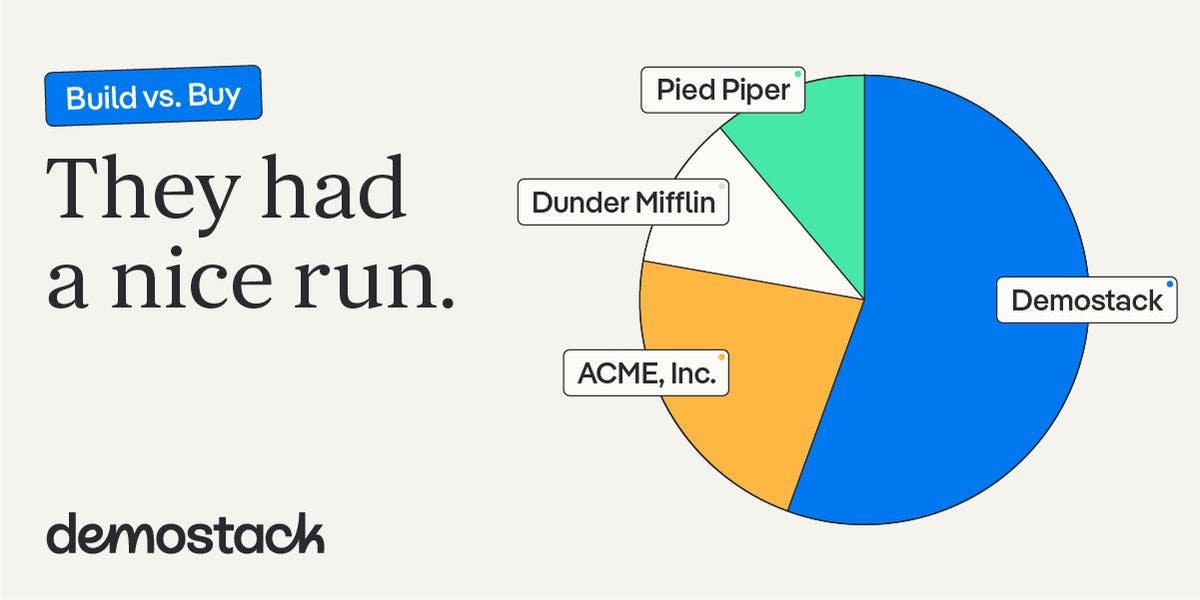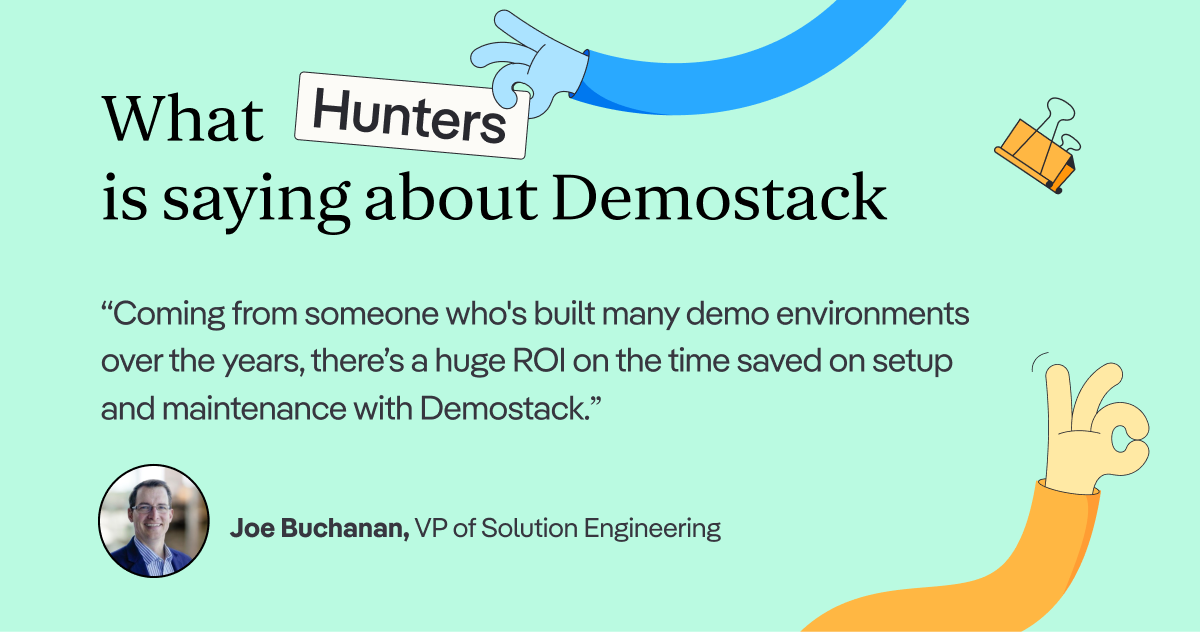More people will see your demo than use your product.
That is, unless your close rate is 100%, in which case we’d love to chat.
But since most B2B sales funnels are, well… funnels, you’re going to have far more eyeballs on your demo than you have active users. So while building an amazing product is where the glory is, having a demo that actually does your product justice can’t be left to the wayside.
If you want to turn prospects into paying customers, you’re going to need a sales demo environment - something that can be shown to prospects on a live demo to help them understand how your product solves their problems.
“Why can’t I just demo out of production?”
We’re glad you asked.
This might seem like the easiest solution, but the problem is, most products were built for being used, not for showcasing. Sales organizations that demo out of production often run into the same problems:
- Sensitive data gets leaked (internal, or worse, your customer’s data).
- Fake accounts need to be filled with dummy data and content.
- Product surprises like bugs or unexpected changes throw off your mojo on live demos.
- Showcasing upcoming features is impossible.
- Access control quickly becomes a nightmare, especially if you’re working with partners.
- Is your production instance the gold star example of an ideal implementation? Most often this is not the case.
Let’s say you’re demoing a healthcare software product for managing electronic health records. Demoing out of production would mean you’re either showing real patient data (a big no no), or you’re constantly piping in dummy data sets to keep the data from appearing outdated. And how will you manage access for sellers that need something to show, but shouldn’t have their hands on that PII either?
While on the surface your production instance might seem like the most obvious solution, it’s much more problematic in practice.
The sales demo environment, built for showcasing
If you can’t show production, then you’re going to need a separate sales demo environment, built specifically for showcasing your product.
So the question then becomes… to build or to buy?
Many organizations looking to spend less on tools would immediately go down the route of building a home-grown demo environment. But demo environments built in house come with their own set of complexities, with data and storytelling at the top of the list again.
This is why ACME Inc. and the likes have gained such a strong market presence - because crafting a tailored story is easier said than done in a home-grown demo environment.
Candidly, it’s why we consider ACME Inc. our biggest competitor.

But how much does standing up a demo environment internally truly save? What’s the opportunity cost of building it internally? How will resources be allocated? How can the story be customized?
Let’s dig into how these two options compare.
Spoiler alert, all options are not created equal.
7 Questions to consider when investing in demo infrastructure
If you’re going to invest in demo infrastructure, there are a few things to consider in order to determine the requirements and find the right solution.
1. COST: How many hours are you spending maintaining demo infrastructure?
Spinning up a demo environment in house is no small task. It takes a significant amount of valuable engineering resources - often to the tune of 80-100 hours per product for mid-market SaaS platforms. And that’s just for the initial setup - nevermind the ongoing maintenance.
For the enterprise, managing demo infrastructure often requires several thousand hours per quarter, and a team focused solely on that.
If that’s the case, you should consider the cost of those FTEs as part of the equation. This often falls on the solution engineering team, but then requires them on every call because of how complex the demo environment is - more on that later.
On the other hand, buying a demo environment solution streamlines the setup and maintenance, so your sales team can focus on selling, and your R&D team on developing the product itself.
Plus, you can usually break even on that investment if it helps you close just one or two more deals. In the words of Joe Buchanan, VP Solution Engineering at Hunters:

2. PERSONALIZATION: Can the product story be customized for each buyer?
An immersive, tailored story is what pulls your buyer in and lets them see the value of your product for their use case. But crafting that product story is a massive headache if you’re using a home-grown demo environment.
First, it probably means someone is constantly piping in dummy data sets and content so that the data in your demo doesn’t look completely outdated. But up-to-date or not, that story is still a generic, one-size-fits-all approach.
A demo environment solution allows you to craft a tailored story for every sales conversation - customized to that specific buyer - all with no code. Piping in dummy data becomes a thing of the past, since you can edit data straight from the front end with a few clicks.
3. BUYER ENABLEMENT: Can the demo environment be shared as a leave-behind?
If you want to take your buying experience to the next level, consider how your demo infrastructure would allow you to get your product into your customer’s hands faster. Sharing a leave-behind demo environment allows them to explore on their own time, and gain buy-in with other stakeholders who weren’t on the call.
The ideal state is to be able to share a link to a demo sandbox full of content and data curated to their business, along with guides to focus the customer on your differentiators and value. Assets like this can help build serious momentum in your deal, make your champion look like a hero internally, remove barriers in their buying process, and help them understand value in no time.
4. SALES ENABLEMENT: Will SEs be required on every demo call?
One theme we hear all the time is that because of how complex the in-house demo environment is, Solution Engineers are required on every live demo call. This creates a huge strain on SE resources, given the ratio of AEs to SEs is usually a lot to a little. Plus, your SE team can provide far more value by spending that time on larger, more strategic deals instead of joining every call with every prospect.
Enabling more teams to show product allows you to not only free up internal resources, but also give your customers a better buying experience if they’re able to see a demo faster. If you’ve got an easy to use demo environment, you can have AEs handle first call micro demos, and only bring in SE resources when a more technical walkthrough is required.
5. RELIABILITY: How will access be managed to ensure stability?
Sharing a demo environment between multiple departments often leads to awkward product surprises during live customer calls…
“That’s odd - it was there yesterday.”
It happens far too often, and forces your sellers to pivot from what they planned to show, often throwing off their game.
Then there’s the partnerships aspect you’ll want to consider if you have any sort of channel sales motion. Unless you want to give your resellers access to your internal demo environment, they’re going to need something for showcasing as well.
Private and shared workspaces in a demo environment solution make access much simpler. With the right access controls on all their demo assets, reps can be sure the content won’t get changed unexpectedly - and your demo becomes far more reliable.
6. MAINTENANCE: How will it be kept up-to-date with new product releases?
Initial setup is one thing, but what about keeping your demo environment up-to-date with new product releases? Sprint timelines seem to only get faster with new technology, which means your demo environment needs to be maintained at the same speed, unless you want to be demoing outdated tech.
Leveraging a demo environment solution makes that much easier, so your demo assets can always stay on par with new product rollouts.
7. PRIVACY: How will sensitive data be secured?
An area that often gets overlooked is personally identifiable information (PII) being shown in your sales demos. Things like names, emails, phone numbers, addresses, credit card information - all of this is considered PII and in order to stay compliant with regulations like HIPAA, GDPR, CCPA it can’t be shown in your demo.
Doing so (even accidentally) can lead to severe ramifications and catastrophic fines - to the tune of 4% of your revenue.
If you’re using a home-grown demo environment, you’ll want to make sure to scrub all that data, or pipe in those dummy data sets we talked about earlier.
Tools like Demostack’s PII Shield make this much easier by identifying and masking any sensitive information found in your demo. You can leverage it to swap out real data with the data you need to craft the right story, without the manual effort.
Demo infrastructure built for scale
When done right, investing in demo infrastructure can have an outsized impact on your top line revenue. Enabling sales with demo assets that are tailored, reliable, and easy to use allows them to be more productive, provides your buyer with a solid demo experience, and ultimately helps you convert more pipeline into revenue.
If you’re looking for a demo environment solution built for scale, we can help.

